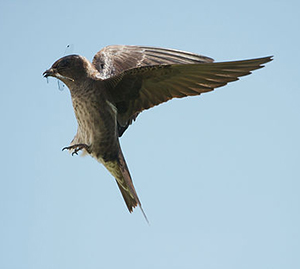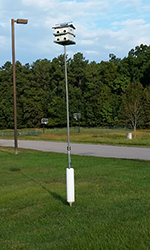The Purple Martin’s History of Dependence on Humans
By Environmental Management System, SEPB
October, 2014

Have you seen the bird houses around campus? No, not the bluebird boxes, but the slightly different one up between Module A and the Memorial Garden? This is a nest box for the purple martin (Progne subis), a relative of the common swallow. NIEHS has also built bird houses for the purple martin at the intersection of Lake Drive and South Park and near the MRI close to the dam.
Unlike many birds, purple martins rely on humans to provide structures for them to nest in. In early America, the Native Americans realized that martins could serve as sentinels and warn of dangers. To encourage the presence of purple martins, Native Americans constructed gourd bird houses and hung them on high poles. Over time, purple martins, especially in the eastern part of the United States, have come to rely on artificially constructed structures. The population of purple martins decreased dramatically in the 20th century as the population of house sparrows rose in North Carolina and competed with martins for nest cavities.
Purple martins migrate south to the Brazilian Amazon Valley during North American winters and return to North American in late February to May. Older birds will return to the same area as the previous year, and if their young find suitable housing, they too will return to the same location. As martins will breed in colonies close to structures, their habitat across the east is patchy, as they will not live where humans have not built nesting structures.

Purple martins will build nests in existing bird houses or structures in early spring. Female martins will then lay five to six white eggs, which will hatch after an incubation period of approximately 15 days. Baby Martins are able to fly on their own 25 days after they are born, although they will remain with their families until it is time to migrate south for the winter.
Purple martins do not eat mosquitoes. Martins only eat while in flight, and mosquitoes do not fly high enough for martins to be interested. Purple martins are generalists, and will all sorts of insects that fly high enough, including flies, dragonflies, bees, stinkbugs, cicadas, flying ants, butterflies, moths, and wasps. Purple martins can be adversely affected by long periods of unexpected summer cooler weather or constant rain, as flying inspects will not fly in such conditions.



